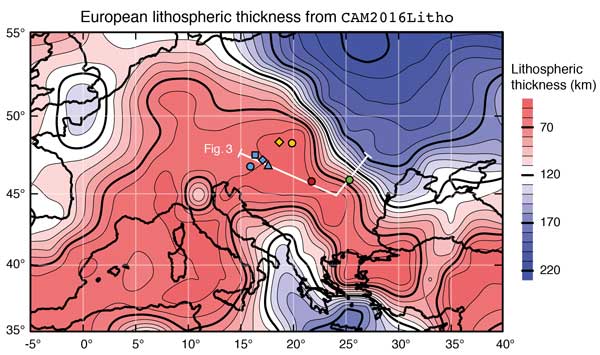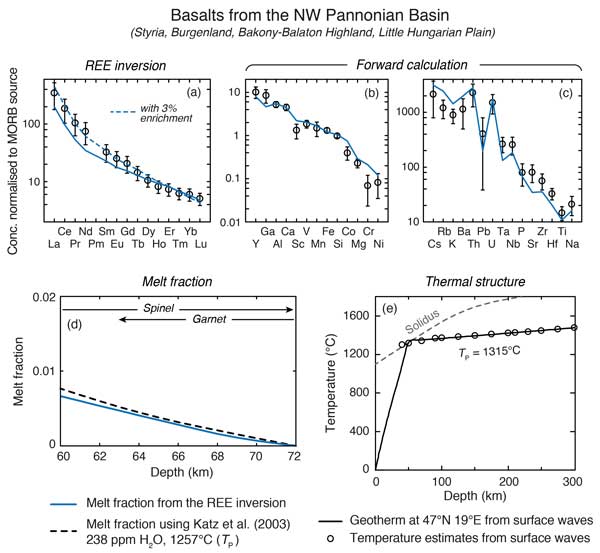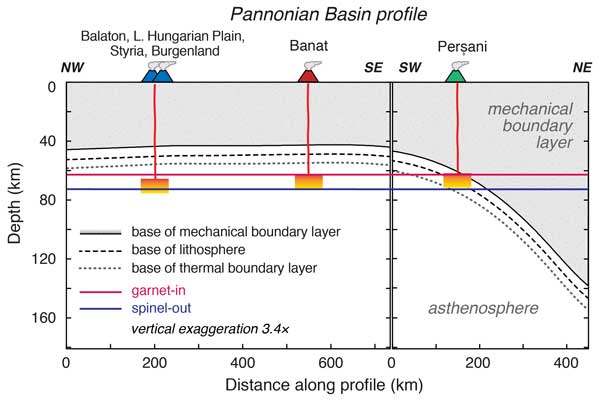 |
The Generation and Source Region of Post-Extensional Intraplate Volcanism in the Carpathian-Pannonian Region |
Antoine J. J. Bracco Gartner1 & Dan McKenzie2
1Faculty of Science, Vrije Universiteit Amsterdam, Amsterdam, The Netherlands; a.j.j.braccogartner@vu.nl
2Bullard Laboratories, Department of Earth Sciences, University of Cambridge, Cambridge, UK; mckenzie@madingley.org
This webpage is a summary of: Bracco Gartner, A. J. J., & McKenzie, D. (2020). Estimates of the Temperature and Melting Conditions of the Carpathian-Pannonian Upper Mantle From Volcanism and Seismology. Geochem. Geophys. Geosys., 21(10), e2020GC009334. https://doi.org/10.1029/2020GC009334
Introduction
The origin of sporadic low-volume basaltic volcanism within continental interiors remains puzzling. It is increasingly evident that many intraplate volcanoes may not be driven by deeply sourced excess heat as originally hypothesised (e.g., Foulger & Natland, 2003). Consequently, a wide variety of conceptual mechanisms have been invoked to explain their origin. The ubiquity and viability of many such mechanisms remain, however, contentious.
A region whose intraplate volcanism is not well understood is the Pannonian Basin and Carpathians in eastern Central Europe (Figure 1). Here, small volumes of alkali basalts were erupted over the last 12 million years (Embey-Isztin et al., 1993; Seghedi et al., 2004), surprisingly after extension in the Basin had ceased (Horváth et al., 2015). To understand the nature of this post-extensional intraplate volcanism, as well as similar instances worldwide, we set out to obtain detailed constraints on the generation of the melt and its source region by modelling the geochemistry of the erupted basalts and mantle nodules and integrating the results with geophysical observations.

Figure 1: Map of lithospheric thickness in Europe from CAM2016Litho, calculated from surface-wave tomography (Priestley et al., 2018). The intraplate volcanic fields marked in the Carpathian-Pannonian region are (from left to right) Styria, Burgenland, the Little Hungarian Plain, the Bakony-Balaton Highland (blue symbols), Central Slovakia and Nógrád-Gömör (yellow), Banat (red), and Perşani (green). The modelling of basalts from the blue locations is shown in Figure 2. The white line is the profile trace of Figure 3.
Modelling Basalt Geochemistry
We inverted the concentrations of rare-earth elements (REEs) in the most primitive basalts from the Carpathian-Pannonian region to determine the melt fraction and the melting depth. We used the INVMEL scheme, which inverts observed REE concentrations for the best-fitting melt distribution as a function of depth for a specified source composition. Details of the modelling are given in Bracco Gartner & McKenzie (2020).
Figure 2a shows the inversion result for the basalts from the NW Pannonian Basin (from Styria, Burgenland, the Bakony-Balaton Highland, and the Little Hungarian Plain). The principal result, as for the other Carpathian-Pannonian basalts shown in our paper, is that their compositions require the mantle to have undergone less than 1% melting in the garnet-spinel transition zone, at depths of about 60–70 km (Figure 2d). Using the melting profile determined by the inversion, we predicted the concentrations of 28 other elements by integrating instantaneous fractional melts over incremental depths. Comparing the calculated and observed concentrations provides an independent test of the melting model obtained from the inversion. Figures 2b and 2c show this comparison and indicate that the melting model effectively produces the average major, minor and trace-element compositions of the basalts.
Furthermore, we show that the inferred source used for the inversions—the basalt source—is consistent with the composition, mineral modes, and clinopyroxene geochemistry of some of the mantle nodules brought up by the basalts throughout the region (details in Bracco Gartner & McKenzie, 2020). The main difference between the nodules, which are garnet-free, and the basalt source is that the latter equilibrated at slightly greater depth.

Figure 2: Constraints on the generation of basaltic melt beneath the Carpathian-Pannonian region. (a) Rare-earth element inversion (black symbols = average observed concentrations ± 1 SD; blue line = best fit from the inversion). (b, c) Forward calculation of 28 other elements (here, blue line = calculated concentrations). All concentrations are normalised to the MORB source. (d) Melt fraction as a function of depth (blue line) as obtained from the REE inversion. This melting profile is compared to that calculated from the parameterisation of Katz et al. (2003) (dashed black line). The best-fitting mantle potential temperature is 1257°C. (e) Temperature estimates in the centre of the Pannonian Basin (47°N, 19°E) from CAM2016T-200 based on surface-wave tomography. This is one of the geotherms used to determine the lithospheric thickness shown in Figure 1 (map) and Figure 3 (profile).
Mantle Temperature
The melt distribution can be used to estimate the mantle potential temperature using the parameterisation of hydrous mantle melting by Katz et al. (2003). Figure 2d compares the melting profile from the REE inversion (blue line) with the melting profile for isentropic melting, calculated using the parameterisation of Katz et al. (2003), that minimises the misfit between the two (dashed black line). It shows that the two profiles can be closely matched. The corresponding, best-fitting potential temperature is 1257°C. It corresponds to a real temperature of 1290°C at a depth of 65 km beneath the Pannonian Basin and is compatible with both the observed volume of volcanic rock and the small melt fractions involved.
Figure 2e shows one of the geotherms, in the centre of the Pannonian Basin (47°N, 19°E), that was used to determine the lithospheric thickness shown in Figure 1 (map) and Figure 3 (profile) from surface-wave tomography. The regional geotherm shows that the lithosphere in the centre of the Basin is thin—only about 50 km. It also shows that the temperature at the base of the lithosphere is very close to that of the dry solidus. Clearly, small volumes of melt can easily be generated near the base of the lithosphere, which indeed is just where the REE inversion shows the melting columns are located. The presence of any water in the mantle—and it is likely that there is some beneath the Basin (Aradi et al., 2017; Kovács et al., 2020; Patkó et al., 2019)—would facilitate melting at the conditions of the dry solidus.

Figure 3: Schematic profile through the Carpathian-Pannonian region that illustrates the melting columns for the Late Miocene–Quaternary intraplate basalts. The profile trace is shown in Figure 1. The base of the lithosphere and thermal and mechanical boundary layers are derived from surface-wave tomography. Depths of the melting columns are derived from the REE inversions (Figure 2a, d).
Melt Generation and Intraplate Volcanism
The inversions show that the intraplate basalts in the Carpathian-Pannonian region are sourced from the garnet-spinel transition zone, at depths of about 60–70 km. Figure 3 illustrates the geophysical architecture of the Pannonian Basin from surface-wave tomography. It shows that all the intraplate magmas beneath the Basin are sourced from the asthenosphere, close to the base of the thermal boundary layer.
The young (Quaternary) intraplate volcanism in the Pannonian Basin is clearly not the result of ongoing extension. The gravity anomalies and topography of the Basin reveal no large-scale features that can account for the post-extensional volcanism. Instead, the lithospheric thickness and geotherm show that melting occurs because the base of the lithosphere, at a depth of about 50 km, is close to or at the solidus temperature over a large part of the Basin. Unless, for example, water or carbon dioxide is introduced into the mantle, the solidus temperature is a monotonically increasing function of depth. Therefore, it appears that there must be some upwelling to account for the volcanism. However, because the volume of melt is so small, the upwelling clearly moves mantle material upwards just enough for it to cross its solidus.
In summary, only a small amount of upwelling is needed to form minor volumes (up to a few cubic kilometres) of basaltic melt immediately below the lithosphere when its base is close to the solidus temperature. Though the thinned lithosphere of the Carpathian-Pannonian region is the result of stretching, ongoing extension is not a prerequisite for the formation of intraplate volcanism. What appears to be required is a relatively thin lithosphere, below which thermal buoyancy is likely to drive upwelling and hence melt production.
References
-
Aradi, L. E., Hidas, K., Kovács, I. J., Tommasi, A., Klébesz, R., Garrido, C. J., & Szabó, C. (2017). Fluid-enhanced annealing in the sub-continental lithospheric mantle beneath the westernmost margin of the Carpathian-Pannonian extensional basin system. Tectonics, 36(12), 2987–3011. https://doi.org/10.1002/2017TC004702
-
Bracco Gartner, A. J. J., & McKenzie, D. (2020). Estimates of the temperature and melting conditions of the Carpathian-Pannonian upper mantle from volcanism and seismology. Geochemistry, Geophysics, Geosystems, 21(10), e2020GC009334. https://doi.org/10.1029/2020GC009334
-
Embey-Isztin, A., Downes, H., James, D. E., Upton, B. G. J., Dobosi, G., Ingram, G. A., et al. (1993). The petrogenesis of Pliocene alkaline volcanic rocks from the Pannonian Basin, eastern Central Europe. Journal of Petrology, 34(2), 317–343. https://doi.org/10.1093/petrology/34.2.317
-
-
Horváth, F., Musitz, B., Balázs, A., Végh, A., Uhrin, A., Nádor, A., et al. (2015). Evolution of the Pannonian Basin and its geothermal resources. Geothermics, 53, 328–352. https://doi.org/10.1016/J.GEOTHERMICS.2014.07.009
-
Katz, R. F., Spiegelman, M., & Langmuir, C. H. (2003). A new parameterization of hydrous mantle melting. Geochemistry, Geophysics, Geosystems, 4(9), 1073. https://doi.org/10.1029/2002GC000433
-
Kovács, I., Patkó, L., Liptai, N., Lange, T., Taracsák, Z., Cloetingh, S. A. P. L., et al. (2020). The role of water and compression in the genesis of alkaline basalts: Inferences from the Carpathian-Pannonian region. Lithos, 354–355, 105323. https://doi.org/10.1016/j.lithos.2019.105323
-
Patkó, L., Liptai, N., Kovács, I. J., Aradi, L. E., Xia, Q.-K., Ingrin, J., et al. (2019). Extremely low structural hydroxyl contents in upper mantle xenoliths from the Nógrád-Gömör volcanic field (northern Pannonian Basin): Geodynamic implications and the role of post-eruptive re-equilibration. Chemical Geology, 507, 23–41. https://doi.org/10.1016/J.CHEMGEO.2018.12.017
-
Priestley, K., McKenzie, D., & Ho, T. (2018). A lithosphere-asthenosphere boundary—Global model derived from multimode surface-wave tomography and petrology. In H. Yuan & B. Romanowicz (Eds.), Lithospheric Discontinuities, Geophysical Monograph Series (Vol. 239, pp. 111–123). Washington, DC: American Geophysical Union (AGU). https://doi.org/10.1002/9781119249740.ch6
-
Seghedi, I., Downes, H., Vaselli, O., Szakács, A., Balogh, K., & Pécskay, Z. (2004). Post-collisional Tertiary-Quaternary mafic alkalic magmatism in the Carpathian-Pannonian region: A review. Tectonophysics, 393(1–4), 43–62. https://doi.org/10.1016/J.TECTO.2004.07.051
last updated 2nd November, 2020 |
